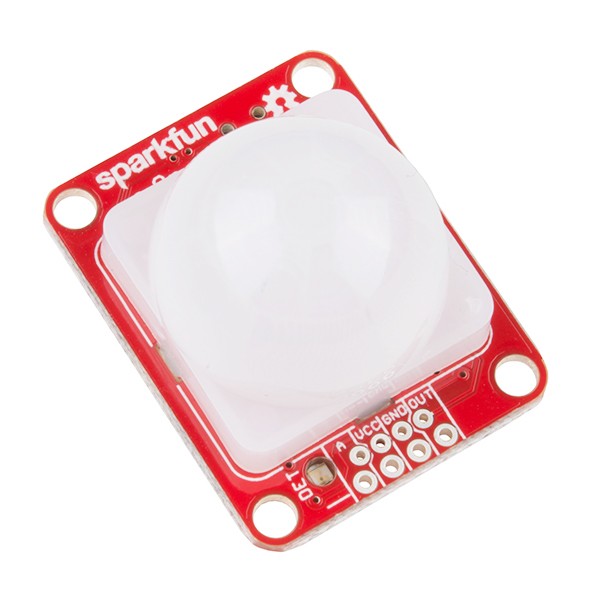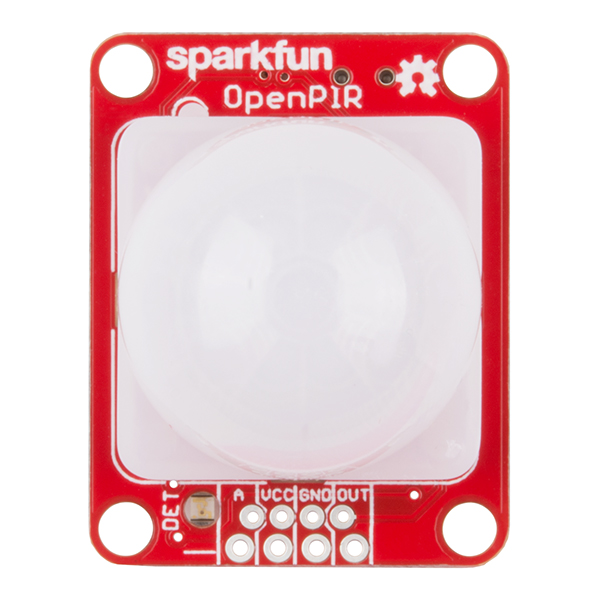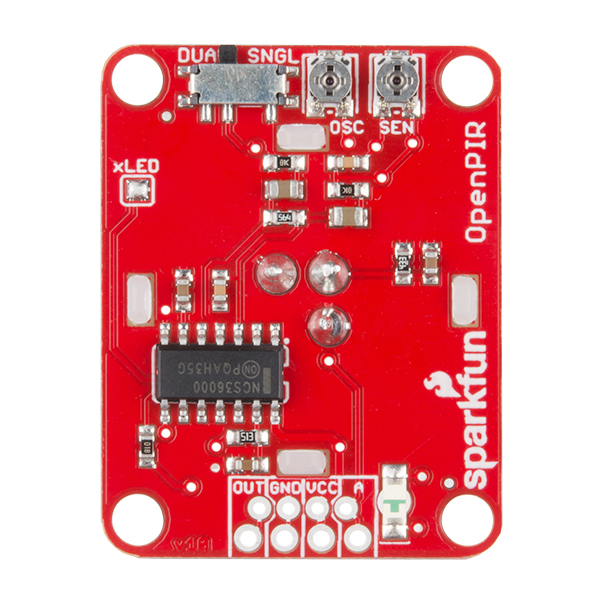SparkFun OpenPIR
The SparkFun OpenPIR is a highly customizable Passive Infrared (PIR) sensor based around the NCS36000 PIR controller. Passive infrared (PIR) sensors are able to detect motion in a small/local area –-- they’re the sensor of choice in security systems, home automation and proximity-sensing applications. The OpenPIR allows you to set the sensitivity, trigger time and pulse mode of the motion sensor so you can tailor-fit it to your application!
The OpenPIR has a multitude of characteristics unique to itself, including two trimpots to adjust sensitivity (view distance) and the oscillator to control the length of time the output remains HIGH, as well as a trigger that supports two motion-detection modes: single-pulse and dual-pulse. Additionally, each OpenPIR is equipped with a reverse-entry green LED, which duplicates the status of the OUT pin. When motion is detected, the LED will illuminate; otherwise it will remain off.
The SparkFun OpenPIR supports a power supply range of 3VDC to 5.75VDC at 80µA standby (3mA when detecting motion) and is able to be connected via a standard 0.1" header or a 4-pin JST PH connector.
- Voltage Supply Range: 3VDC to 5.75VDC
- Standby Average Current: 80µA
- Motion-Detected Average Current: 3mA (LED enabled)
- Integrated 2−Stage Amplifier
- Internal LDO to Drive Sensor
- Internal Oscillator with External RC
- Single or Dual Pulse Detection
- Schematic
- Eagle Files
- Hookup Guide
- Datasheet (NCS36000)
- GitHub
SparkFun OpenPIR Product Help and Resources
Papa Soundie Audio Player Hookup Guide
April 26, 2018
Add sound effects to your project, prop or costume with Papa Soundie Audio Player.
Core Skill: Soldering
This skill defines how difficult the soldering is on a particular product. It might be a couple simple solder joints, or require special reflow tools.
Skill Level: Noob - Some basic soldering is required, but it is limited to a just a few pins, basic through-hole soldering, and couple (if any) polarized components. A basic soldering iron is all you should need.
See all skill levels
Core Skill: Programming
If a board needs code or communicates somehow, you're going to need to know how to program or interface with it. The programming skill is all about communication and code.
Skill Level: Rookie - You will need a better fundamental understand of what code is, and how it works. You will be using beginner-level software and development tools like Arduino. You will be dealing directly with code, but numerous examples and libraries are available. Sensors or shields will communicate with serial or TTL.
See all skill levels
Core Skill: Electrical Prototyping
If it requires power, you need to know how much, what all the pins do, and how to hook it up. You may need to reference datasheets, schematics, and know the ins and outs of electronics.
Skill Level: Rookie - You may be required to know a bit more about the component, such as orientation, or how to hook it up, in addition to power requirements. You will need to understand polarized components.
See all skill levels
Comments
Looking for answers to technical questions?
We welcome your comments and suggestions below. However, if you are looking for solutions to technical questions please see our Technical Assistance page.
Customer Reviews
4.7 out of 5
Based on 6 ratings:
Nice configurable PIR motion sensor
I've had the chance to play around with the OpenPIR for the past week and it works great for a post mail box activity monitor project I'm doing. I was bothered at first that it took several minutes to boot up after power on, but come to find out it had to do with the OSC pot. After trying a few adjustments to the point where the LED came on for just a second and half to indicate movement did speed up the boot/initialization considerably.
Much better than the cheap ones
More sensitive, 3.3 and 5v tolerant and more adjustable. Worth every penny.
Good performance, nice sized package....
This worked out really well as a proof of concept design for one of my clients. The 'open' design leaves me with a lot of options as we go forward on future designs. My wife wants me to incorporate this into my next iteration of an under cabinet light system for our kitchen.
Does the job
The OpenPIR is easy to set up and use. The analog output allows a better view of how the sensor is actually responding to movement. The digital output can be used for straightforward on/off control purposes.
I'm using the sensor to turn on and off the LED backlight of an LCD display. The display I'm replacing has been on for many years and I've learned the even LEDs loose their output level over time, albeit over a long period of time.
Just what I needed.
I have purchased at lot of different PIR modules for evaluation (over a dozen) and this one seems to work the best. Set up the PIR to a counter to measure false triggers. None so far, but it's only been about a week. If all testing works out, I may be purchasing a lot more. Please keep these in stock. Using 4 c-cell batteries in a small enclosure, I think the battery life should be >5 years, due to the low 80 microamp standby current. Thanks again.
This device is excellent!
I designed and built a motion detector for my house using this device and an ESP-8266. I have built 6 of these and installed 4 in various locations so far. They work perfectly, detecting the presence of people without a lot of false positives. I did have a lot of false positives initially with one unit in the front of my house which turned out to be caused by cars driving by. Once I repositioned it so that it wasn't "seeing" the street, the problem went away and it reliably detects when people walk up the driveway. Also, one of the units I bought quit working soon after I started using it. SparkFun replaced it with no hassle and at no charge. Neither of these problems were caused by an inherent problem, so it gets 5 stars.






What is the max. detection distance and 3-D detection profile?
When the trim pot for sensitivity is at midpoint (as it is at time of purchase) it will detect a person at 6-8 feet (2-2.5m) away. The maximum range is about 16 feet (5m), give or take a bit.
For an idea of the detection profile, check out this document. Page 15 of the document has the profile for the CWM 0.5 GI V1 lens we use on this product.
What is the viewing angle (field of view) that the sensor can detect?
Is the detection area just span horizontally, or is it both vertical and horizontal viewing angle that it can detect in?
Could this detect a squirrel? I'm making a nut dispenser :D
I need a QWIIC version for use with ESP products that lack ADCs.
Edit: Oh, it has a digital mode. I still want a QWIIC version though!